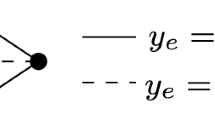Abstract
Given a graphG = (N, E) and a length functionl: E → ℝ, the Graphical Traveling Salesman Problem is that of finding a minimum length cycle goingat least once through each node ofG. This formulation has advantages over the traditional formulation where each node must be visited exactly once. We give some facet inducing inequalities of the convex hull of the solutions to that problem. In particular, the so-called comb inequalities of Grötschel and Padberg are generalized. Some related integer polyhedra are also investigated. Finally, an efficient algorithm is given whenG is a series-parallel graph.
Similar content being viewed by others
References
J.A. Bondy and U.S.R. Murty,Graph theory with applications (North-Holland, Amsterdam, 1976).
G. Cornuéjols, D. Naddef and W.R. Pulleyblank, “Halin graphs and the travelling salesman problem”,Mathematical Programming 26 (1983) 287–294.
J. Edmonds, “Matroids and the greedy algorithm”,Mathematical Programming 1 (1971) 127–136.
B. Fleischmann, “Linear programming approaches to travelling salesman and vehicle scheduling problems”, Technical Report, Universität Hamburg (paper presented at the XI. International Symposium on Mathematical Programming, Bonn, 1982).
B. Fleischmann, “A new class of cutting planes for the symmetric travelling salesman problem”, Report No. QM-03-83, Institut für Unternehmensforschung, Universität Hamburg (1983).
G.N. Frederikson and J. Jager, “On the relationship between biconnectivity and travelling salesman problems”,Theoretical Computer Science 19 (1982) 189–201.
M. Grötschel and M.W. Padberg, “On the symmetric travelling salesman problem I, II”,Mathematical Programming 16 (1979) 265–302.
W. Pulleyblank, “Faces of matching polyhedra”, Ph.D. Thesis, University of Waterloo (Waterloo, Ontario, 1973).
D. M. Ratliff and A.S. Rosenthal, “Order-picking in a rectangular warehouse: A solvable case of the travelling salesman problem”,Operations Research 31 (1983) 507–521.
K. Takamizawa, T. Nishizeki and N. Saito, “Linear time computability of combinatorial problems on series-parallel graphs”,Journal of the ACM 29 (1982) 632–641.
J.A. Wald and C.J. Colbourn, “Steiner trees, partial 2-trees and minimum IFI methods”,Networks 13 (1983) 159–167.
Author information
Authors and Affiliations
Additional information
Work was supported in part by NSF grant ECS-8205425.
Rights and permissions
About this article
Cite this article
Cornuéjols, G., Fonlupt, J. & Naddef, D. The traveling salesman problem on a graph and some related integer polyhedra. Mathematical Programming 33, 1–27 (1985). https://doi.org/10.1007/BF01582008
Received:
Revised:
Issue Date:
DOI: https://doi.org/10.1007/BF01582008




